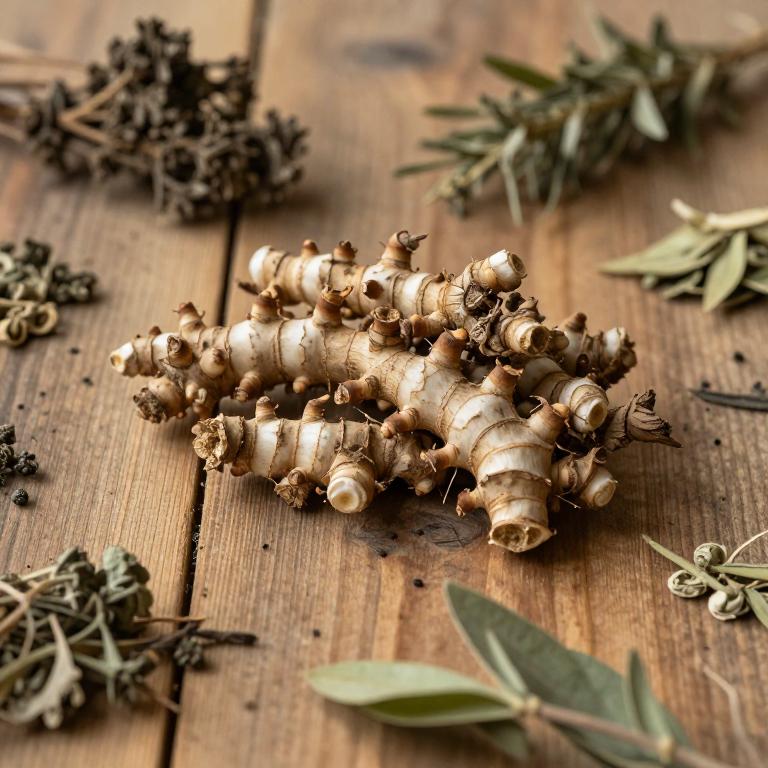Ginger (Zingiber Officinale)
Information Reliability Score: 5/10
This score reflects the overall reliability of the information presented in this article. It is based on the quality of scientific evidence, accuracy of sources, and the transparency of references related to Zingiber officinale.

Common Ginger, scientifically known as zingiber officinale, is a medicinal herb, adaptogen, and spice widely used for its therapeutic properties.
It is renowned for its primary benefits, including anti-inflammatory, antioxidant, and digestive support, which contribute to its popularity in both traditional and modern wellness practices. Historically, it has been used in Ayurvedic and Chinese medicine to alleviate nausea, reduce menstrual cramps, and boost immunity, while in modern times, it is commonly consumed as a tea or supplement to support gut health and reduce stress. One of its unique features is the presence of the rare active compound gingerol, which gives it a distinctive spicy, pungent flavor and contributes to its medicinal effects.
With a rich history dating back thousands of years, Common Ginger remains a staple in global cultures for both culinary and therapeutic purposes.
FREE CHECKLIST
The Only 10 Herbs You Need to Heal 90% of Common Ailments.

Table of Contents
Scientific and Botanical Profile
Common Ginger, with botanical name Zingiber officinale, is a herbaceous plant belonging to the family Zingiberaceae, known for its aromatic rhizomes that are widely used in culinary and medicinal applications.
Native to Southeast Asia, India, Indonesia, Malaysia, China, the Philippines, and Myanmar, it has been cultivated for thousands of years. Morphologically, Common Ginger features a thick, creeping rhizome covered in a thin, fibrous sheath, with erect, grass-like stems and narrow, lance-shaped leaves that are often hairy on the underside. The plant produces small, fragrant flowers in terminal clusters, typically in shades of yellow or red, followed by ellipsoid, yellowish fruits.
Common Ginger, also known as Zingiber, Ginger, and Zingiber Officinale, is a key component in traditional medicine and a staple in global cuisine.
History and Cultural Relevance
Common Ginger was used for thousands of years across various cultures for its medicinal and culinary properties, dating back to ancient Egypt, India, and China, where it was revered for its therapeutic benefits.
In traditional Ayurvedic and Chinese medicine, ginger has been employed to treat digestive issues, nausea, and inflammation, making it a cornerstone of holistic health practices. It also plays a significant role in cultural rituals, such as being used in religious ceremonies and as a symbol of prosperity in some Asian societies. Today, its traditional remedies like ginger tea for colds and ginger supplements for nausea remain widely practiced, reflecting its enduring relevance in both modern and traditional healthcare.
The plant's historical and cultural significance continues to shape its global appreciation and use in diverse communities.
Chemical Composition and Nutritional Profile
Common Ginger contains a complex array of bioactive compounds, including essential oils, phenolic compounds, flavonoids, and terpenes, which contribute to its distinctive aroma and therapeutic properties.
Among its active components, gingerol and shogaol are the primary bioactive substances responsible for its anti-inflammatory and antioxidant effects. Nutritional-wise, it is rich in vitamins such as vitamin C, vitamin B6, and minerals like magnesium and potassium, along with dietary fiber and small amounts of protein. These nutrients and compounds work synergistically to support digestion, reduce nausea, and modulate inflammatory responses in the body.
The mechanism of action involves the inhibition of pro-inflammatory cytokines and the enhancement of gastrointestinal motility, making ginger a valuable natural remedy for various health conditions.
Medicinal Properties and Health Benefits
Zingiber officinale has long been recognized for its potent medicinal properties, offering a wide range of health benefits across multiple body systems.
It is particularly renowned for its anti-inflammatory, antioxidant, and digestive stimulating effects, which support the gastrointestinal, respiratory, and immune systems. The active compounds in ginger, such as gingerol and shogaol, help alleviate nausea, reduce muscle pain, and combat oxidative stress, making it a popular remedy for conditions like motion sickness and arthritis. Compared to similar herbs like turmeric or garlic, ginger stands out for its rapid onset of action and stronger thermogenic effects, though it may be less potent in anti-inflammatory compounds than curcumin.
Its versatility and ease of use in both culinary and medicinal forms further enhance its appeal as a natural health supplement.
Discover the 10 best health benefits of Ginger.
Forms, Preparation and Usage
Zingiber officinale has a wide variety of forms, including fresh rhizomes, dried powder, tinctures, essential oils, and capsules, each offering different methods of preparation and usage.
It can be prepared as a tea by steeping fresh or dried rhizomes in hot water, or as a decoction by boiling the root for a longer period. Topical applications include rubbing the fresh ginger or its oil on the skin for pain relief or muscle soreness. The recommended dosage for adults is typically 250-500 mg of dried powder in capsule form, while children should only use it under medical supervision, with a lower dose.
Usage should be limited to short durations, typically no more than a few weeks, to avoid potential side effects and ensure safe, conservative use.
Safety, Side Effects and Contraindications
Zingiber officinale can be a beneficial medicinal plant, commonly used for its anti-inflammatory, digestive, and circulatory properties, but it must be used with caution.
While generally safe when consumed in moderate amounts, it may cause side effects such as gastrointestinal discomfort, heartburn, or allergic reactions in some individuals. Zingiber officinale may interact with certain medications, including blood thinners, antidiabetic drugs, and anti-platelet agents, potentially increasing the risk of bleeding or lowering blood sugar levels. Special populations, such as pregnant or breastfeeding women, should consult a healthcare provider before use due to limited safety data, and it is contraindicated in those with bleeding disorders or gastrointestinal ulcers.
To ensure safe use, it is recommended to follow recommended dosages, avoid prolonged use, and consult a healthcare professional, especially if taking other medications or managing chronic health conditions.
Growing, Harvesting and Storage
Zingiber officinale grows best in well-drained, fertile soil with a slightly acidic to neutral pH, requiring full sun to partial shade and consistent moisture.
It thrives in warm, humid climates and benefits from regular watering without becoming waterlogged. For optimal growth, plant rhizomes in spring after the last frost, and fertilize with a balanced organic fertilizer every few months. Harvest the rhizomes when the leaves turn yellow and begin to wither, typically 8 to 10 months after planting, by gently digging them up and cleaning the roots.
To preserve potency, dry the rhizomes in a shaded, well-ventilated area or use a dehydrator, then store them in airtight containers in a cool, dark place or refrigerate for extended shelf life.